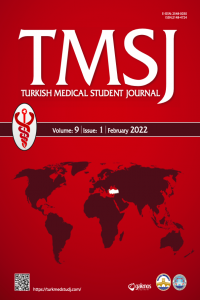THE IMPACT OF OPEN INGUINAL HERNIA MESH REPAIR ON QUALITY OF LIFE
THE IMPACT OF OPEN INGUINAL HERNIA MESH REPAIR ON QUALITY OF LIFE
Inguinal hernia, quality of life, mesh repair,
___
- 1. Jenkins JT, O'Dwyer PJ. Inguinal hernias. BMJ 2008;336(7638):269– 72. 2. Hammoud M, Gerken J. Inguinal hernia. StatPearls (serial online) 2019 Jan (cited 2019 Feb). Available from: URL: https://www.ncbi. nlm.nih.gov/books/NBK513332/?report=reader#_NBK513332_ pubdet_. 3. HerniaSurge Group. International guidelines for groin hernia management. Hernia 2018;22(1):1-165. 4. Sharma P, Boyers D, Scott N et al. The clinical effectiveness and cost-effectiveness of open mesh repairs in adults presenting with a clinically diagnosed primary unilateral inguinal hernia who are operated in an elective setting: systematic review and economic evaluation. Health Technol Assess 2015;19(92):1-142. 5. Naguib N, ElSamerraai A. No-mesh inguinal hernia repair with continuous absorbable sutures: is it a step forward or backward?. Saudi J Gastroenterol 2009;15(1):68-9. 6. Bringman S, Ramel S, Heikkinen TJ et al. Tension-free inguinal hernia repair: TEP versus mesh-plug versus Lichtenstein: a prospective randomized controlled trial. Annals of surgery 2003;237(1):142- 7. 7. Rutegård M, Gümüsçü R, Stylianidis G et al. Chronic pain, discomfort, quality of life and impact on sex life after open inguinal hernia mesh repair: an expertise-based randomized clinical trial comparing lightweight and heavyweight mesh. Hernia 2018;22(3):411-18. 8. Sanders DL, Waydia S. A systematic review of randomised controled trials assessing mesh fixation in open inguinal hernia repair. Hernia 2014;18:165–176. 9. Heniford BT, Walters AL, Lincourt AE et al. Comparison of generic versus specific quality-of-life scales for mesh hernia repairs. J Am Coll Surg 2008;206(4):638-44. 10. Turaga K, Fitzgibbons RJ, Puri V. Inguinal hernias: should we repair? Surg Clin North Am 2008;88:127–38. 11. Primatesta P, Goldacre MJ. Inguinal hernia repair: incidence of elective and emergency surgery, readmission and mortality. Int J Epidemiol 1996;25:835–9. 12. Burcharth J, Pedersen M, Bisgaard T et al. Nationwide prevalence of groin hernia repair. PLoS One 2013;8(1): e54367. 13. Öberg S, Andresen K, Rosenberg J. Etiology of inguinal hernias: acomprehensive review. Front Surg 2017;4(52):1-8. 14. Knox RD, Berney CR. A preoperative hernia symptom score predicts inguinal hernia anatomy and outcomes after TEP repair. Surg Endosc 2015;29(2):481–6. 15. Lawrence K, McWhinnie D. Quality of life in patients undergoing inguinal hernia repair. Ann R Coll Surg Engl 1997;79(1):40-5. 16. Lins L, Carvalho FM. SF-36 total score as a single measure of health-related quality of life: scoping review. SAGE Open Medicine 2016;4:1-12.
- ISSN: 2148-4724
- Başlangıç: 2014
- Yayıncı: Trakya Üniversitesi
Irmak İrem ÖZYİĞİT, Alperen Taha CERTEL, Begüm SÖYLEYİCİ, Sezgin KEHAYA
IL-17/TNF-α BISPECIFIC ANTIBODIES AS NEW THERAPEUTIC APPROACH TO RHEUMATOID ARTHRITIS
CANNABINOID RECEPTORS ARE NOT INVOLVED IN ANTINOCICEPTION INDUCED BY SYSTEMIC DICLOFENAC IN MICE
Beiza CHATZİSALİ, Tolga GAŞ, Hilmi KILGIN, Kübra Duvan AYDEMİR, Dilşat ERÜMİT, Ruhan Deniz TOPUZ, Ahmet ULUGÖL
Gonca AKSU, Sercan SARAN, Mahmut Sami OFLAZ, Mert ÇİFTDEMİR
CLINICOPATHOLOGICAL FEATURES OF MYELOID SARCOMA PATIENTS FROM A SINGLE CENTER EXPERIENCE
Fatih Erkan AKAY, Hakkı Onur KIRKIZLAR, Elif MERCAN, Fulya ÖZ PUYAN
THE IMPACT OF OPEN INGUINAL HERNIA MESH REPAIR ON QUALITY OF LIFE
Elif CENGİZ, Toprak Kağan AKSU, Hilal Sena ÇİFCİBAŞI, Tuğrul DEMİREL
ARROW CAUSE OF ANGINA PECTORIS: SINGLE CORONARY ARTERY ANOMALY IN ELDERLY PATIENT
